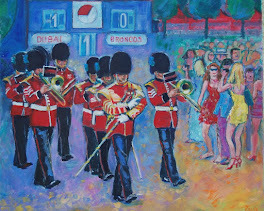EDWARD BURRA MAJOR SHOW UNTIL 21 FEBRUARY 2012
Chichester, Sussex is where you can see a fantastic exhibition of the watercolour works of Edward Burra.
First, though, remember it is a very sloooooow train journey to Chichester from London, Victoria. Maybe go by car? But then you probably cannot park.
Anyway, we got there by lunchtime and had a job to find Pallant House Gallery, it is in North Pallant, down a little street called West Pallant, off South Street. Apparently there is a very good restaurant there, called Field and Fork, but we did not try it out. No time.
CAFE ROUGE
Instead we went to Cafe Rouge and I did this pencil sketch, where the figure in the foreground reminded me of drawings of Mr Pickwick.
 |
| Chichester, Cafe Rouge diners |
It is new, and next to an 18th century house where the gallery was based originally. The Edward Burra show is upstairs and in galleries with low light because the paintings are watercolour.
You are probably aware of the kinds of paintings you will see. There are some very large ones, on papers stuck together.
The first gallery has smaller work, and includes some of my favourites, of the bars and streets of Harlem and London. Burra visited cities from his family home near Rye, Sussex and it seems he loved to travel. The earlier works dated from the 1920s so presumably he went by train and sea. Probably he liked to draw the dockhands and sailors en route.
 |
| EDWARD BURRA, ZOOT SUITS |
SIMON MARTIN - CURATOR
I was pleased to overhear the start of a talk, when arriving in the first gallery, from Simon Martin, Head of Curatorial Services. Mr Martin addressed a small group of ladies, who kept giving us daggers looks because we dared to overhear the remarks. Maybe they expected us to put our hands over our ears so we could not hear what he said!
HAMMER HORROR
There were some good information labels in the galleries. I did not realize that Burra liked films so much, apparently he tried to go to the cinema two or three times a week. One painting was of Mae West. He also liked Hammer Horror films. The later paintings are very strange and rather frightening, and sometimes show skeletons, skulls and figures with birds heads.
FLOWER PAINTING
I saw one flower painting, which was itself very eerie and disturbing, with garish yellows. Not your usual pretty, pretty flower stuff at all.
LORRIES
The later works often included views of rolling hills and motorways crossing moorlands and downs. The lorries and cars were painted in almost a naive way. Once again, these dark, brooding images were something you might find rather disturbing. They were a far cry from the earlier works showing people enjoying life, in theatres, cafes, dance halls and streets.
PAUL NASH
Apparently Burra kept very close, lifelong friendships with the people he knew when a student at Chelsea Polytechnic and the Royal College. He also knew Paul Nash, mainly because he lived quite near, and discussed art with him but I think I read that he did not liked Nash's work. Other painters who he admired include Gustave Moreau, Otto Dix, George Grosz, Max Beckman, Goya, Leger and Hogarth.
He was briefly associated with Surrealism. But moved away from this.
TOURIST POSTCARDS
According to the information in the gallery, Burra sometimes used postcards when painting, he also probably used his own photographs, some of which were on show in the gallery. Hastings Harbour in the exhibition an example of his use of postcards.
He had an amazing visual memory, though and towards the end of his working life, liked to go out with his sister in her car, after which he could start a landscape painting from memory. That was his preferred method of working.
EYES
You might notice that the eyes of a lot of the figures, have a sideways look; the pupils are right at the corner of the eye, as if his people cannot look anybody straight in the face.
WORKS ON DISPLAY IN THE EXHIBITION
There is a small selection of Burra's main works here on display. Obviously there is a lot more to be seen dotted around the world, and it is unfortunate that watercolour is such a transient medium; maybe that is why major galleries cannot put more on display.
One thing I did miss seeing was more sketches. There were a few pencil and pen sketches on show.
BOOK: EDWARD BURRA, Simon Martin
I bought this book, even though at £25 it is more than I like to pay! But have started reading it and find it excellent, and very funny in places, where it quotes his letters which are really bitchy and witty.
















